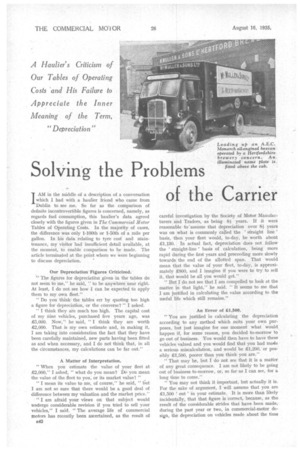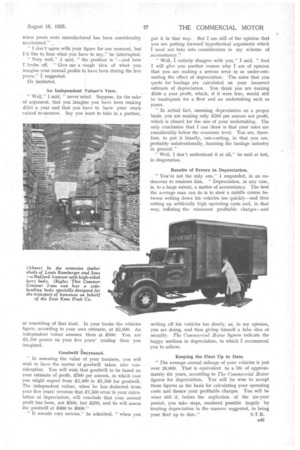Solving the Problems of the Carrier
Page 52

Page 53

If you've noticed an error in this article please click here to report it so we can fix it.
IAM in the middle of a description of a conversation which I had with a haulier friend who came from Dublin to see me. So far as the comparison of definite incontrovertible figures is concerned, namely, as regards fuel consumption, this haulier's data agreed closely with the figures given in The Commercial Motor Tables of Operating Costs. In the majority of cases, the difference was only 1-100th or 1-50th of a mile per gallon. In his data relating to tyre cost and Maintenance, my visitor had insufficient detail available, at the moment, to enable comparison to be made. The article terminated at the point where we were beginning
to discuss depreciation. '
Our Depreciation Figures Criticized.
"The figures for depreciation given in the tables do• not seem to me," he said, "to be anywhere hear right. At least, I do not see how I can be expected to apply them to my own fleet."
"Do you think the tables err by quoting too high a figure for depreciation, or the converse?" I asked. 'I think they are much too high. The capital cost of my nine vehicles, purchased five years ago, was £5,000. Now," he said, "I think they are worth £2,000. That is my own estimate and, in making it, I am taking into consideration the fact that they have been carefully maintained, new parts having been fitted as and when necessary, and I do not think that, in all the circumstances, my calculations can be far out."
A Matter of Interpretation.
"When you estimate the value of your fleet at £2,000," I asked, "what do you mean? Do you mean the value of the fleet to you; or its market value? "
" I mean its value to rile, of course," he said, " but I am not so sure that there would be a good deal of difference between my valuation and the Market price."
"I am afraid your views on that subject would undergo considerable revision if you tried to sell your vehicles," I said. "The average life of commercial motors has recently been ascertained, as the result of
B42 careful investigation by the Society of Motor Manufacturers and Traders, as being 8i years. If it were reasonable to 'assume that depreciation over Si years was on what is commonly called the straight line' basis, then your fleet would, to-day, be worth about £1,130. In actual fact, depreciation does not follow the ' straight-line ' basis of calculation, being more rapid during the first years and proceeding more slowly towards the end of the allotted span. That would mean that the value of your fleet, to-day, is approximately £800, and I imagine if you were to try to sell it, that would be all you would get."
"But I do not see that I am compelled to look at the matter in that light," he said. " It seems to me that I am justified in calculating the value according to the useful life which still remains."
An Error of £.1,500.
"You are justified in calculating the depreciation according to any method which suits your own purposes, but just imagine for one moment what would happen if, for some reason, you decided to-morrow to go out of business. You would then have to have these vehicles valued and you would find that you had made a serious miscalculation, and would be £1,200, or possibly 41,500, poorer than you think you are."
"That may be, but I do not see that it is a matter of any great consequence. I am not likely to be going out of business to-morrow, or, so far as I can see, for a long time to come."
"You may not think it important, but actually it is. For the sake of argument, I will assume that you are £1,500 ' out' in your estimate. It is more than likely incidentally, that that figure is correct, because, as the result of the considerable strides that have been made, during the past year or two, in commercial-motor design, the depreciation on vehicles made about the time when yours were manufactured has been considerably accelerated."
"I don't agree wfth your figure for one moment, but I'd like to hear what you have to say," he interrupted.
" Very well," I said, " the position is "—and here broke off. "Give me a rough idea of what you imagine your annual profits to have been during the he years," I suggested.
He hesitated.
An Independent Valuer's View.
"Well," I said, " never mind. Suppose, for the sake of argument, that you imagine you have been making £500 a year and that you have to have your stock valued to-morrow. Say you want to take in a partner, or something of that kind. In your books the vehicles figure, according to your own estimate, at 22,000. An independent valuer assesses them at £500. You are
£1,500 poorer on your five years' trading than you imagined.
Goodwill &creased.
"In assessing the value of your business, you will wish to have the matter of goodwill taken into consideration. You will wish that goodwill to be based on your estimate of profit, £500 per annum, in which case you might expect from £1,000. to £1,500 for goodwill_ The independent valuer, when he has deducted from your five years' revenue that £1,500 error in your calculation of depreciation, will conclude that your annual
profit has been, not £500, but £200, and he will assess the goodwill at £400 to £600."
" It sounds" very serious," he admitted, " when you put it in that way. But I am still of the opinion that you are putting forward hypothetical arguments which I need not take into consideration in my scheme of accountancy.''
"Well, I entirely disagree with you," said. "And I will give you another reason why I am of opinion that you are making a serious error in so under-estimating the effect of depreciation. The rates that you quote for haulage are calculated on your incorrect estimate of depreciation. You think you are making £500 a yearprofit, which, if it were true, would still be inadequate for a fleet and an undertaking such as yours.
"In actual fact, assessing depreciation on a proper basis, you are making only £200 per annum net profit, which-is absurd for the size of your undertaking. The only conclusion that I can draw is that your rates are considerably below the economic level. You are, therefore, to put it bluntly, rate-cutting, in that you are, probably unintentionally, harming the haulage industry in general."
" Well, I don't understand it at all," he said at last, in desperation.
Results of Errors in Depreciation.
"You're not the only one," I responded, in an endeavour to reaisure him. "Depreciation, in any case, is, to a large extent, a matter of accountancy. The best the average man can do is to steer a middle course between writing down his vehicles too quickly—and thus setting up artificially high operating costs and, in that way, inflating the minimum profitable charges—and writing off his vehicles too slowly, as, in my opinion, you are doing, and thus giving himself a false idea of security. The Commercial Motor figures indicate the happy medium in depreciation, to which I recommend you to adhere.
Keeping the Fleet Up to Date, "The average annual mileage of your vehicles is just over 26,000. That is equivalent to a life of approximately six years, according to The Commercial Motor figures for depreciation. You will be wise to accept those figures as the basis for calculating your operating costs and thence your profitable charges. You will be wiser still if, before the expiration of the six-year period, you take steps, rendered possible largely by treating depreciation in the manner suggested: to bring your fleet up to date."




















































































